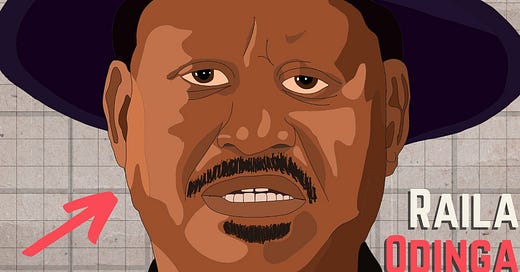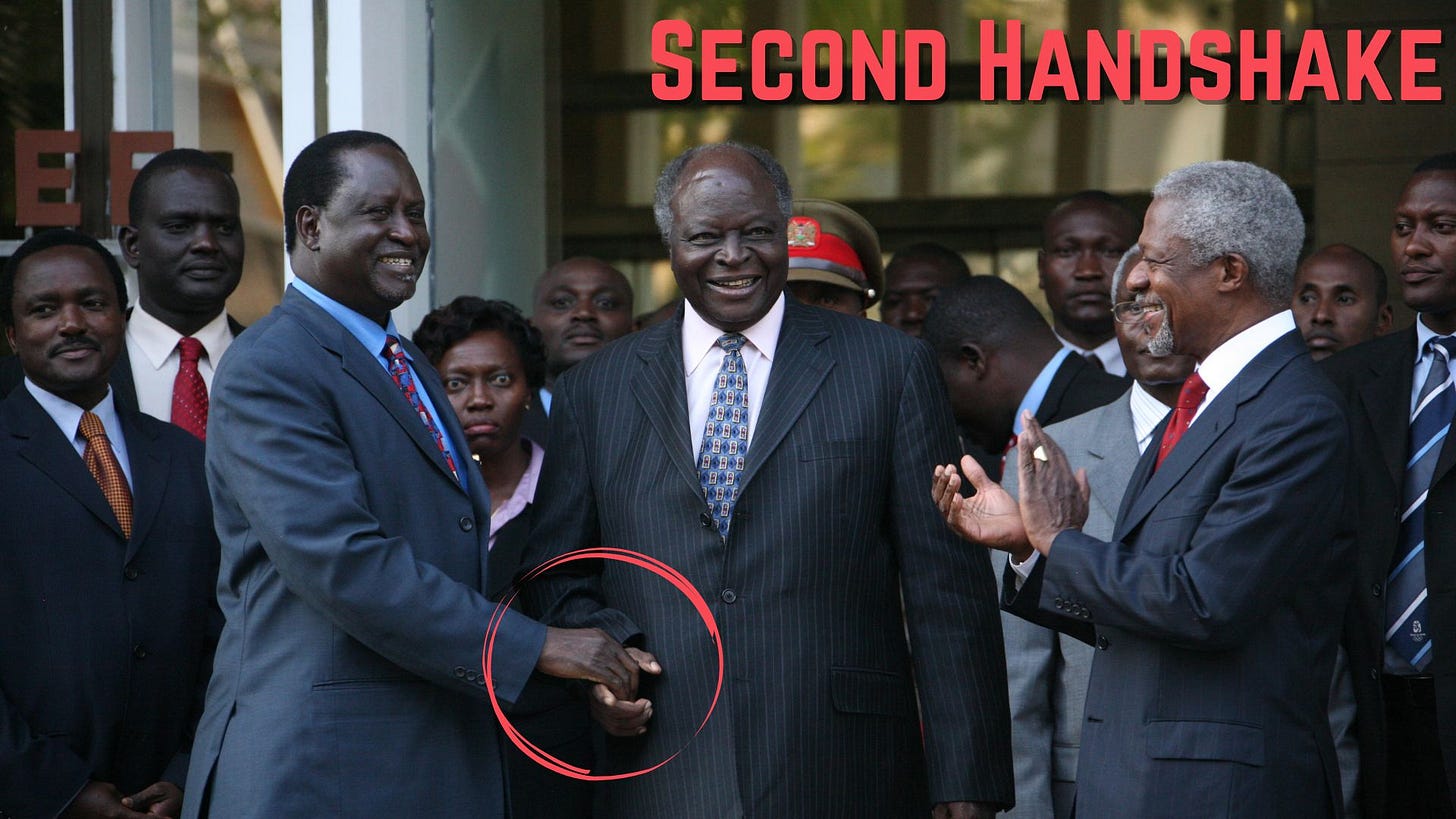Meet Raila Odinga: Africa's Most Successful Failure
He looks set to become the next Chairperson of the African Union Comission. But his past is as interesting as his future.
The Mysterious One
Imagine a modern railway network that connects African capital cities. An African passport with free movement of people on the continent. A pan-African university. An African Monetary Fund. An African Space Programme.
They may sound like fantasies, but in fact these are projects the African Union has committed to achieving by 2063. The organisation responsible to making them a reality, is the African Union Commission. And its next leader, is likely this man: Raila Odinga.
Outside of Kenya, Odinga isn’t that famous. He’s never been president. But in Kenya, he is something of a legend. He is called ‘Agwambo’: The Mysterious One.
Odinga is full of paradoxes. He has lost 5 presidential elections but over the past 30 years, he has received more votes than any other politician in Kenya. He has protested injustice and election rigging, but then turned around to do a deal with his biggest enemies. Odinga’s dance with power is always unpredictable.
So, lets pull back the shroud of mystery and discover how a cold war smuggler, skyrocketed to become Africa’s next boss.
Handshakes?
‘I will continue with this handshake doctrine’ - Raila Odinga
Its 2022 and things are hotting up in the Kenyan elections. William Ruto is facing off against Raila Odinga. And they’re arguing. Not about taxes or projects. The issue is handshakes.
‘I want to assure Kenyan’s I will continue with this handshake doctrine’. Odinga promised his supporters. ‘For the sake of Kenya, I will shake the hand of my rivals’.
Ruto was having none of it. ‘I believe in the rule of law, I do not believe in handshake stories’ he told a crowd. ‘We will not have a handshake.’
So why were handshakes suddenly so controversial? To understand that you need to learn a bit more about Raila Odinga.
Political Animal
Raila was born in Maseno, a large town in Kenya, in 1945. His father became an important figure in Kenya’s liberation struggle and eventually became vice-president. This prestigious role opened opportunities for his son and young Raila finished high school and was shipped off to study in East Germany.
Raila spent 8 years in Germany, first learning the language, then training as a welder. On trips to the Communist side of Berlin, he reportedly smuggled luxury products to friends.
After graduating with a certificate in welding and metal work, he returned to Kenya and started a company building petroleum cannisters. Welding is not an obvious route into politics, but in 1970s Kenya, Raila was one of the most qualified metal workers in the country and a leading businessman. In 1974 he took on a role at the government agency responsible for safe metal working. By 1978 he had risen to become deputy director of the agency.
Raila’s connections through his father helped. But he also had a natural skill himself. He could navigate a tense board room or difficult manager. He could do backdoor deals with different kinds of people. He was a political animal.
But this soon got him into some very hot water.
Quest for Justice
By the 1980s, Kenya’s second president, Daniel Arap Moi, was increasingly unpopular with sections of the army. Some politicians felt the office of the president had too much power. In 1982, soldiers in the Airforce launched a failed coup. Over 900 people were arrested and accused of supporting the traitors.
This included Raila and his father, who were rumoured to have funded the coup attempt. Raila’s promising political career seemed to be over. He was arrested for treason and held without trial for 6 years.
But his unfair detention made him an icon for human rights reform in Kenya. Released in 1988, he began to campaign for a fair democratic system, becoming especially popular amongst members of his Luo ethnic group.
Standing up to the government made Raila popular but put him in a dangerous position. Six months after his release he was arrested again. For the next 3 years Raila was constantly in and out of prison. He became part of a reform movement pressuring the government to allow free elections.
By 1991 pressure was mounting against the government. Since Raila wasn’t intimidated by arrest, the authorities became more desperate. Officials in the American Embassy told Raila they believed he might be assassinated.
Disguised as a Catholic priest, Raila was smuggled out of Nairobi under the name Father Augustine. At Lake Victoria he took a boat into Uganda where he connected with the UNHCR. When the UN heard Kenyan secret police were searching for Raila in Kampala, they urged him to seek asylum elsewhere.
Raila changed disguises, becoming Haji Omar, a Ugandan Muslim wearing a Fez and going on Haj to Mecca. His connecting flight went through Oslo, where he disembarked and was granted asylum by the Norwegian government.
A year later the Kenyan government caved into the demands of reformers. The first multi-party election was held. Raila returned home to Kenya and supported his father who was running for president. In the end his father, Odinga Odinga, only received 18% of the vote.
My Father’s Son
Two years later the elder Odinga died. He left a big hole, especially amongst Luo people. He was popularly known as the ‘Ker’. An ancient title reserved for a legendary Luo King.
Odinga’s cloak fell to the young Raila. Raila formed a new party and contested his first presidential election in 1997. He gained just 10% of the vote, but the party had a strong support base in the Luo heartlands.
By 2000 Raila still had an excellent international reputation. Kenya’s democratization had led to a rise in ethnic violence, but Raila could hardly be blamed for this. In fact, it was Moi who seemed to thrive on these divide and rule tactics. No, Raila was his father’s son: a man of principal, a proud Luo, and defender of human rights. The kind of man who ‘should be president’ but probably never will be. And then everything suddenly changed overnight.
First Handshake
Working for the government standards agency in the 1980s Raila had risen through the ranks because of a willingness to compromise and ability to read the room. He had been persecuted for standing up to the government, but he was still a political animal dancing with power.
In 2000 he entered a coalition government with his long-time enemy Daniel Arap Moi. Yes, the man who had imprisoned Raila for 8 years and forced him to flee Kenya. In exchange Raila was appointed Energy Minister. His first taste for ministerial power. But he paid a heavy price. Some of his loyalist supporters now accused him of being a ‘sell-out’. Rumour had it, Moi might appoint Raila as his successor.
The alliance fell apart when Moi endorsed another candidate and Raila and his allies left to form the National Rainbow Coalition. Here Raila campaigned for Mwai Kibaki as president on the condition he be appointed Prime Minister. But after their election victory, Raila found himself out in the cold.
Second Handshake
Angered by Moi and Kibaki’s betrayal, he launched another political party, the Orange Democratic Movement, and prepared for the 2007 elections. For the first time Raila looked a serious prospect for president. Polls showed he and Kibaki were neck and neck.
But in December Kibaki was declared the winner by just 200,000 votes. Raila complained there was election rigging. Kibaki hurriedly swore himself in. And Kenya descended into violence. People like Kenya’s current president, William Ruto, were accused of stoking the flames of ethnic violence. Raila escaped this accusation. He simply believed the results were inaccurate.
Despite rejecting the results, Raila eventually agreed to do a deal with Kibaki and in 2008 he was appointed Prime Minister with Kibaki as president. Kenyans were left wondering, did his willingness to compromise save Kenya from a civil war, or did it weaken democracy by allowing inaccurate results to stand.
Loosing (unfairly)
Whatever the case, by 2013, Raila’s reputation as a man of principal has been overshadowed by his reputation as a compromiser. The man who does handshakes with his worst enemies. Facing the son of Kenya’s first president in a two-horse race, Raila gained just 44% of the vote losing his third presidential election.
Again, Raila complained there was widescale rigging and brought a case to the supreme court. It later emerged the electronic voting system had serious flaws, and false votes had been counted. But mindful of the 2007 violence, the court upheld the result.
By 2017 he was ready to give it another go. Raila’s coalition looked set to unseat Kenyatta’s government. But before the results were even announced Raila claimed there was massive fraud in the Electoral Commission.
Raila achieved 43% of the vote but claimed almost 2 million votes had been stolen from his party. He again brought the case to the Supreme Court and to everyone’s surprise (including Raila’s) they agreed with him and annulled the election results.
But Raila refused to part take in another election. Instead, he had himself sworn in as the people’s president. The government responded by shutting down TV stations for a month. Kenya looked ready to descend to the chaos of 2007.
Third Handshake
This standoff led Raila to his third famous handshake, this time with Kenyatta, the man he believed had stolen two elections from him. In 2018 the two of them agreed to put their differences aside. For the good of Kenya. And their own careers.
Raila and Kenyatta formed the Azimio coalition, and Kenyatta promised to support Raila in the 2022 elections. Again, Raila’s supporters asked themselves if he was a hero or sell-out. His third handshake led him to a fifth presidential election.
Final Handshake
By 2022 Raila found himself facing the younger William Ruto and things got personal. Ruto attacked Raila’s history of compromise. Remember the handshake speeches at the start of the story? Raila tried to make it positive: ‘We are the party who unclench our fist and stretch out our hand’ he said. Ruto suggested Raila was untrustworthy and didn’t stick to his principles. Handshakes were a threat to healthy democracy.
Once again Raila lost an election by a tiny margin.
Kenyans attracted by Ruto’s promise of no compromises will have been disappointed to see him shaking Raila’s hand and endorsing him as a candidate for the African Union Commission just two years later.
Its often said there are no true friends in politics. Raila’s career shows there aren’t real enemies either. Its interesting though, how a 40-year dance with power can be reduced to 4 big handshakes.
With Ruto under pressure from protesters in Kenya, he has formed a coalition government with Raila’s party to try and build consensus. In exchange, Raila has become Ruto’s AU candidate. Africa’s next big boss.
So will the Mysterious One be a good fit for the African Union? In many ways he has the perfect skills to negotiate and manoeuvre difficult political situations. He will make many political handshakes. And perhaps that’s how big projects, like an African passport, will become a reality.
Sources:
https://nation.africa/kenya/news/politics/ruto-i-won-t-entertain-handshakes-3938062
https://panafricanvisions.com/2022/01/the-genesis-of-raila-and-rutos-feud/












